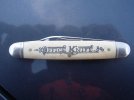What is Mammoth Ivory?
In general terms ivory is a hard, white material from the tusks and teeth of animals. Ivory mainly consists of dentine. Irrespective of the species of origin, the chemical structure of the teeth and tusks of mammals is the same.
More specifically, mammoth ivory stems from the
tusks of any species of mammoth which belongs to the extinct elephantid genus called
Mammuthus. Our mammoth ivory stems from the woolly mammoth
(scientific name: Mammuthus primigenius) which was the last species of the genus Mammuthus. Woolly mammoths went extinct around 4000 years ago.*
The term “mammoth ivory” encompasses what is often referred to as “mammoth bark”.
Mammoth bark forms the outer layer of a
mammoth tusk, while mammoth ivory is the
inner core of a tusk (for analogy think trees). Mammoth bark has fascinating patina textures and unique natural colourations while mammoth ivory has a uniform texture and typical “ivory” colourations (usually white or creamy-white).
For hundreds of thousands of years, the woolly, northern or Siberian mammoths, were inhabiting the vast permafrost plains of the Arctic. Permafrost is ground that continuously remains below 0°C (32°F) for two or more years. It is formed from ice holding various types of soil, sand, and rock in combination. The extremely cold Siberian climate coupled with permafrost provide the best conditions for excellent preservation of the species’s remnants such as bones, carcasses,
molars and tusks.
The excellent climatic conditions of Siberia for the preservation of mammoth ivory are not to be interpreted as a guarantee that mammoth tusks are always discovered in good condition or as whole pieces. Recovering whole mammoth tusks in top-quality condition is a rarity. Discovering a mammoth tusk pair which belonged to the same animal is literally like finding a needle in a giant haystack.
In reality, most of the time only smaller
mammoth ivory pieces are recovered. These fragments are often broken, cracked, decayed and covered in layers of tough mud which has built up over thousands of years. In addition, these mammoth ivory pieces (including bark or
tusk fragments) are almost always soaked with moisture on the inside. This requires a delicate drying procedure which lasts for many months (often years) under controlled climatic conditions.
Because of the poaching of African Elephants, many countries have banned the import of modern Ivory. Smugglers have been marking shipments of modern ivory as fossil ivory to get it past customs. Here in the United States, beginning with New Jersey and New York, state legislators have been...
www.aaps-journal.org








